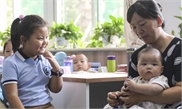
Photo: Xinhua
The official data released Friday showed China’s birth rate hit a record low as the country continues to face the menace of aging population. Although the country has not recorded negative population growth, the latest figures reflected severe structural and demographic problems, which is alarming and merits policy attention, analysts noted.
But they argued that there is no population crisis so far.
With the overall population exceeding 1.4 billion in 2019, China’s birth rate fell to its lowest in nearly seven decades. In 2019, the number of newborns dropped by 580,000 to 14.65 million, with the birth rate standing at 10.48 per 1,000, according to the official data released by the National Bureau of Statistics Friday.
It marked consecutive declines in the country’s newborn figures. Chinese mothers gave birth to 15.23 million in 2018, marking the lowest number since 1961.
The birth rate of 2019, lower than the 10.94 per 1,000 in 2018 and 12.43 per 1,000 in 2017, was also the lowest recorded since 1952, Ning Jizhe, head of the NBS said at a press conference on Friday.
Instead of depicting the sharp decline as a population crisis, Chinese analysts noted the demographic change is within a normal range, although it reflected severe demographic challenges the country is facing.
Zhai Zhenwu, president of the School of Sociology and Population Studies at the Renmin University of China, believes the number of newborns in 2019 conformed to expectations of around 14.5 million.
“The number of 14.65 million newborns is still quite large compared to the US, where the annual newborn population stands at around 4 million,” Zhai said.
Ning said during the press conference that “although the birth rate in 2019 was lower than that in 2018, the decline was smaller, with the full implementation of the second-child policy playing a significant role.”
According to Ning, the second child accounted for 57 percent of all births in 2019 due to the implementation of the second-child policy.
“The declining birth rate reflects China has more elderly people and less young people, but the birth rate remained at a normal range,” Zhai told the Global Times.
China’s demographic development indeed faces growing challenges, as the numbers of newborns are expected to continue dropping in the coming years due to structural adjustments, analysts predicted.
Since the number of women in childbearing age in China is decreasing by about 5 million every year in recent years, the number of births will also decline year-after-year, He Yafu, a demographer, told the Global Times. He predicted China will continue to witness decline in newborns in the following years.
“We haven’t seen a full-fledged policy adjustment from family planning to encouraging families to have more babies. Take Japan as an example, its government incentives are unprecedented but its fertility rates continue declining, which reflected population crisis,” Tian Yun, vice director of the Beijing Economic Operation Association, told the Global Times on Friday.
“We still have a lot to do [to encourage more childbirths],” he said.
According to a Green Book of Population and Labor co-released by the Chinese Academy of Social Sciences and Social Sciences Academic Press in January 2019,the turning point of China’s population could arrive around 2028 after the population peaks to 1.44 billion. However, many demographics experts said this estimation is too optimistic. They estimated the year 2023 or 2024 to be the threshold for population negative growth.
He Yafu acknowledged the huge role the second-child policy has played in birth rates as normally the number of the first child should be greater than the second child, however, he cautioned an increase in maternal mortality rate.
The national ratio of maternal mortality in the first half of 2016 has witnessed an increase of 30.6 percent over the same period last year after the country began to implement the two-child policy in January this year.
But the latest Health News report in May 2019 shows the infant mortality rate in China dropped to 6.1 per 1,000 from 33.2 per 1,000 in 1998, and the maternal mortality rate dropped from 56.2 per 100,000 in 1998 to 18.3 per 100,000 as of 2018 end.
During the past years, the country has been improving medical partnership and telemedicine, and contracted family doctor services to relocate more resources to grassroots health institutions, offering the public more equitable access to basic medical services, the Xinhua News Agency reported.
Analysts also suggested China come up with more policies to encourage couples for childbirth, in order to overcome the demographic challenges.
“China should further lift its family planning policy to remove all birth limitations, but it might have little effect on improving the current birth rate,” Zhai said.
A 34-year-old white-collar living in Beijing surnamed Song told the Global Times Friday she is “too busy to have kids,” although she is married for more than five years.
“Chinese young women today have also their career to pursue, I’m not sure whether it’s a good time for me to shift my focus from work to family,” she said.




